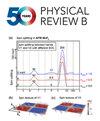具有强无序性的孤立量子多体系统中缓慢弛豫的 Kohlrausch 机制及其现象学
IF 3.7
2区 物理与天体物理
Q1 Physics and Astronomy
引用次数: 0
摘要
本文章由计算机程序翻译,如有差异,请以英文原文为准。
Kohlrausch regime of slow relaxation and its phenomenology in isolated quantum many-body systems with strong disorder
The Kohlrausch(-Williams-Watts) law of stretched exponential relaxation has been observed for over a century and a half in diverse complex classical systems. Here we show that this law describes relaxation quite generically in closed (executing Schrödinger dynamics), interacting disordered many-body systems, using interaction range and disorder strength as primary tuning parameters. This we observe for both time-independent and periodically driven (Floquet) systems. Finite-size analysis indicates the persistence of this nonthermal relaxation regime in the thermodynamic limit thus defining a distinct dynamical regime. This regime exhibits a peak in the time scale of the long-time relaxation (following a transient), upon crossing over from weak to strong disorder. We provide a simple picture of this behavior, which naturally accounts for its generic occurrence. Formation of spin-glass — one of the possible mechanisms for stretched relaxation appears incidental to the occurrence of Kohlrausch law in our context. Finally, we provide a simple non-Hermitian Hamiltonian formulation for the dynamics of a single spin embedded in the disordered chain. This provides an analytical formula that captures not only the Kohlrausch relaxation of the disorder averaged autocorrelation but also captures the largely diverse dynamics of an arbitrary target spin in the system. Our work hence also provides a concrete quantification of the “prethermal slowness” in many-body disordered system. Published by the American Physical Society 2025
求助全文
通过发布文献求助,成功后即可免费获取论文全文。
去求助
来源期刊

Physical Review B
物理-物理:凝聚态物理
CiteScore
6.70
自引率
32.40%
发文量
0
审稿时长
3.0 months
期刊介绍:
Physical Review B (PRB) is the world’s largest dedicated physics journal, publishing approximately 100 new, high-quality papers each week. The most highly cited journal in condensed matter physics, PRB provides outstanding depth and breadth of coverage, combined with unrivaled context and background for ongoing research by scientists worldwide.
PRB covers the full range of condensed matter, materials physics, and related subfields, including:
-Structure and phase transitions
-Ferroelectrics and multiferroics
-Disordered systems and alloys
-Magnetism
-Superconductivity
-Electronic structure, photonics, and metamaterials
-Semiconductors and mesoscopic systems
-Surfaces, nanoscience, and two-dimensional materials
-Topological states of matter
 求助内容:
求助内容: 应助结果提醒方式:
应助结果提醒方式:


